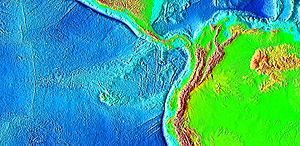
Galapagos Rise
Encyclopedia

Divergent boundary
In plate tectonics, a divergent boundary or divergent plate boundary is a linear feature that exists between two tectonic plates that are moving away from each other. Divergent boundaries within continents initially produce rifts which produce rift valleys...
located between the South America
South America
South America is a continent situated in the Western Hemisphere, mostly in the Southern Hemisphere, with a relatively small portion in the Northern Hemisphere. The continent is also considered a subcontinent of the Americas. It is bordered on the west by the Pacific Ocean and on the north and east...
n coast and the triple junction
Triple junction
A triple junction is the point where the boundaries of three tectonic plates meet. At the triple junction a boundary will be one of 3 types - a ridge, trench or transform fault - and triple junctions can be described according to the types of plate margin that meet at them...
of the Nazca Plate
Nazca Plate
]The Nazca Plate, named after the Nazca region of southern Peru, is an oceanic tectonic plate in the eastern Pacific Ocean basin off the west coast of South America. The ongoing subduction along the Peru-Chile Trench of the Nazca Plate under the South American Plate is largely responsible for the...
, the Cocos Plate
Cocos Plate
The Cocos Plate is an oceanic tectonic plate beneath the Pacific Ocean off the west coast of Central America, named for Cocos Island, which rides upon it.-Geology:...
, and the Pacific Plate
Pacific Plate
The Pacific Plate is an oceanic tectonic plate that lies beneath the Pacific Ocean. At 103 million square kilometres, it is the largest tectonic plate....
. The volcanically active Galapagos Islands
Galápagos Islands
The Galápagos Islands are an archipelago of volcanic islands distributed around the equator in the Pacific Ocean, west of continental Ecuador, of which they are a part.The Galápagos Islands and its surrounding waters form an Ecuadorian province, a national park, and a...
exist on the Galápagos hotspot
Galápagos hotspot
The Galápagos hotspot is a volcanic hotspot in the East Pacific Ocean responsible for the creation of the Galapagos Islands as well as three major aseismic ridge systems, Carnegie, Cocos and Malpelso which are on two tectonic plates. The hotspot is located near the Equator on the Nazca Plate not...
above the Galapagos Rise. The Galapagos Microplate
Galapagos Microplate
The Galapagos Microplate is a small tectonic plate off the west coast of South America near the Galapagos Islands. It differs from most other crustal plates in that it is rotating clockwise between three much larger crustal plates around it, the Nazca, Cocos and Pacific Plates...
is a small separate plate on the rise just to the southeast of the triple junction.
The Cocos Ridge trends northeasterly from the Galapagos to the coast of Costa Rica
Costa Rica
Costa Rica , officially the Republic of Costa Rica is a multilingual, multiethnic and multicultural country in Central America, bordered by Nicaragua to the north, Panama to the southeast, the Pacific Ocean to the west and the Caribbean Sea to the east....
and Panama
Panama
Panama , officially the Republic of Panama , is the southernmost country of Central America. Situated on the isthmus connecting North and South America, it is bordered by Costa Rica to the northwest, Colombia to the southeast, the Caribbean Sea to the north and the Pacific Ocean to the south. The...
. The Carnegie Ridge
Carnegie Ridge
The Carnegie Ridge is an aseismic ridge on the Nazca Plate that is currently being subducted beneath the South American Plate. The ridge is thought to be a result of the passage of the Nazca Plate over the Galapagos hotspot...
trends almost due east to the Ecuador
Ecuador
Ecuador , officially the Republic of Ecuador is a representative democratic republic in South America, bordered by Colombia on the north, Peru on the east and south, and by the Pacific Ocean to the west. It is one of only two countries in South America, along with Chile, that do not have a border...
ian coast.
The Galapagos Rise is a currently active ridge. Fernandina Volcano on Fernandina Island
Fernandina Island
Fernandina Island is the third largest, and youngest, island of the Galápagos Islands. Like the others, the island was formed by the Galápagos hotspot...
, the most westerly island of the chain erupted on May 12, 2005 ejecting a column of ash that rose to a height of seven km from a fissure on the west side of the volcano. Volcanic ash fell on neighboring Isabela Island
Isabela Island (Ecuador)
Isabela Island is the largest island of the Galápagos with an area of , and length of nearly 4 times larger than Santa Cruz, the next largest of the islands. This island was named in honor of Queen Isabella of Spain, who sponsored the voyage of Columbus. . By the English, it was named Albemarle...
. Alcedo Volcano
Alcedo Volcano
Alcedo Volcano is one of the six coalescing shield volcanoes that make up Isabela Island in the Galapagos. The remote location of the volcano has meant that even the most recent eruption in 1993 was not recorded until two years later...
on Isabela Island last erupted in the 1950s.

